Cerebrovascular Lab

Principal Investigator
Dr. E. Sander Connolly’s Cerebrovascular (CV) Laboratory focuses primarily on the study of strokes. A stroke is an injury to the brain caused by a lack of blood supply. This can be caused by either a blood clot (ischemic stroke) or a tear (hemorrhagic stroke) in a blood vessel. The exact mechanisms of both stroke types are complex.
The scientific focus of the CV lab is on the effects of inflammation that occurs in the brain following stroke. Past research has shown that inhibiting this inflammation can help patients more completely to regain function after different types of stroke.
In particular, the lab has focused on the role of the complement cascade, a complex immune response system that has been shown to lead to programmed cell death after stroke. It also plays an important role in utilizing the brain’s own natural stem cell reserves to populate regions of the brain after injury. Through collaboration with a multidisciplinary team, these basic science discoveries are rapidly investigated in an effort to find ways to help patients.
To that end, Dr. E. Sander Connolly has just completed phase II of an FDA-funded, multi-center, clinical trial looking at the use of the drug tiopronin, also called Thiola, in patients with a hemorrhagic stroke near the surface of the brain (subarachnoid hemorrhage). Thiola has been FDA-approved for the treatment of kidney stones since the mid 1980s and preliminary data from Dr. Connolly’s lab suggests that this drug can also protect brain cells. Specifically, it has been shown to protect neurons against both apoptosis (self destruction) and cytotoxic cell death (exposure to the body’s own toxins) following stroke. More information about this clinical trial, The Effects of Tiopronin on 3-Aminopropanal Level & Neurologic Outcome After Aneurysmal Subarachnoid Hemorrhage, is listed below:
- The drug was chosen in part because it has very few and very mild side effects. It completed a phase I trial at Columbia in 2010 without any side effects in patients with subarachnoid hemorrhage.
- The phase II part of the study has just completed enrollment and will examine whether or not the drug affects levels of 3-aminopropanal in the blood and spinal fluid. 3-aminopropanal is a chemical that accumulates after injury and causes further brain cell death.
- Patients will also be followed to observe if and how much the drug improves their neurologic status after subarachnoid hemorrhage. Collaborating principle investigators participating in this trial include Dr. Brian L. Hoh, an Associate Professor in the Department of Neurosurgery at the University of Florida, Dr. J Mocco from the Neurological Surgery Department at Vanderbilt University Medical Center, and Dr. Louis J. Kim from the Neurosurgery Department at the University of Washington.
Other clinical research efforts include studying the way blood vessels react to injury or malformations within the brain. Specifically, blood vessels can change their diameter to affect the amount of blood flowing through them. When blood vessels narrow or constrict (a process called vasospasm), blood flow decreases and this can result in cell death. Vasospasm is a common complication of subarachnoid hemorrhage, and the development of aneurysms.
They are also interested in the effect that arteriovenous malformations (AVM) have on the auto-regulation of blood flow. An AVM is an abnormal tangle of blood vessels within the brain that has a high risk of bleeding. Dr. E. Sander Connolly has collaborated for nearly 15 years with Dr. Eric Heyer, a neuro-anesthesiologist who specializes in improving cognitive ability after carotid endarterectomy, a surgical procedure where plaque build-up is removed from the vessel walls. Together they have built a valuable database of patients undergoing this procedure at Columbia with meticulous preoperative and postoperative cognitive testing that has allowed them to determine key factors that lead to poor cognitive outcome, illuminating potential avenues of treatment to improve outcome.
The laboratory also maintains close collaboration with the neuro-intensive care physicians Dr. Jan Claassen and Dr. Stephan Mayer. Together they have published dozens of scientific articles on the treatment of patients with different types of brain hemorrhage, stroke, and arteriovenous malformations.
The well does not run dry. Dr. Connolly’s lab currently supports a resident researcher, a full time clinical coordinator, a biostatistician, multiple full time medical students, a full-time international medical student, an international post-doc, and numerous part time medical, college, and high school students. A brief discussion with his students makes it clear that his is an enthusiastic and engaging mentor to scientists at all levels of training.
